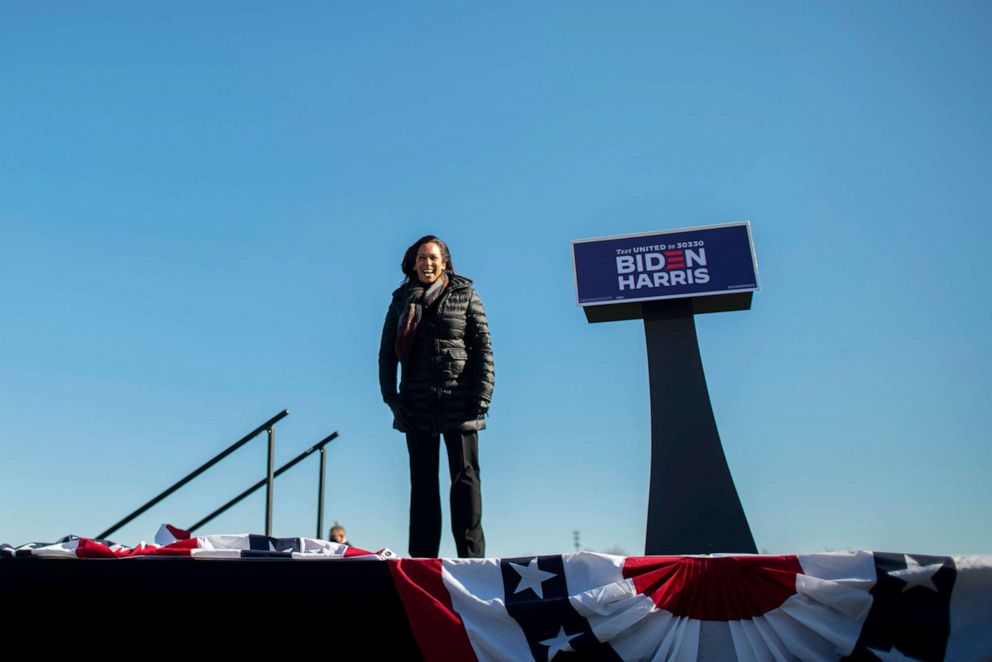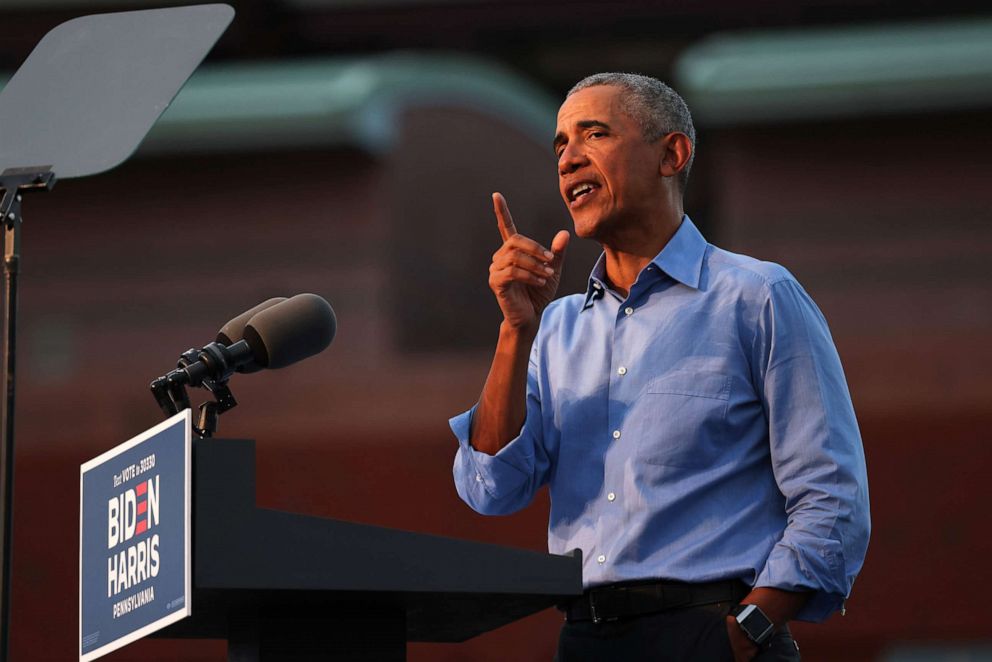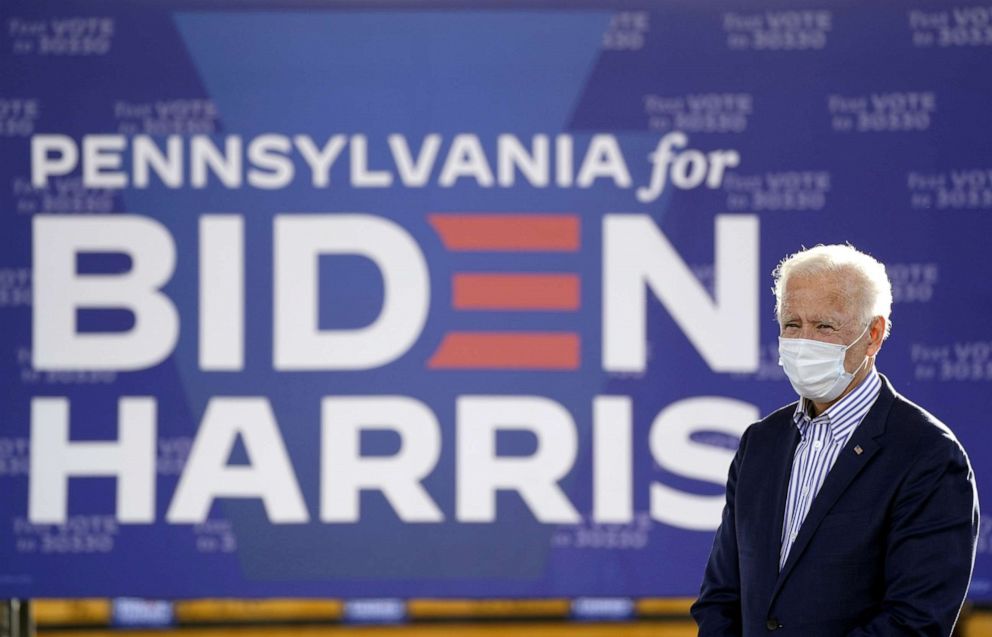How Democrats took Pennsylvania back from Trump in the 2020 election
President-elect Joe Biden's campaign staff said their strategy paid off.
A big part of President-elect Joe Biden's victory hinged on Pennsylvania's 20 electoral votes.
Biden has a lead of more than 65,000 votes in Pennsylvania. The state, which was part of the Democratic "blue wall" that collapsed four years ago, went to President Donald Trump by more than 44,000 votes in 2016.
Both Trump and Biden campaigned heavily in the Keystone State in the days leading up to the election. While Pennsylvania has Democratic strongholds in Philadelphia and Pittsburgh, to win the state, Biden needed to improve upon former Secretary of State Hillary Clinton's 2016 performance in rural communities and smaller towns.
Rachel Thomas, the Northeast communications director for the Biden campaign, said that was the plan. She stressed that it was important to the campaign that they give "every voter the dignity of asking for their vote and not taking any single community for granted."

She added, "Our campaign, from the outset, ran an all-of-the-above approach. So, we knew that in order to win Pennsylvania, we couldn't just focus on one particular type of voter or group or region but that we really needed to engage everyone."
Thomas said the Pennsylvania Democratic Party partnered with the campaign to maximize resources. Sinceré Harris, the senior advisor to Biden's campaign in Pennsylvania, said their strategy was not one that started overnight or even in the primaries.
"I think the party recognized that we needed to invest in a really strong ground game," Harris said. "We wanted to make sure we had grassroots, labor, the party infrastructure ... and we knew that investing early was going to be important."
Voter engagement delivered, as turnout was at unprecedented levels. In 2016, over 6 million people voted in Pennsylvania. In 2020, more than 6.7 million people showed up at the polls in the state.
"We were able to build the broadest, most diverse coalition," Thomas said. "We reached out not just to people that we knew would support us, but we were actively working to persuade and bring Independents and Republicans over to our side."
This statewide approach can be seen throughout Pennsylvania, which saw an increased turnout among Democrats in predominately red areas as well as blue areas. According to the Pennsylvania Department of State, in 2016 Clinton received 33% of the vote in York County, a traditionally Republican area. This year, Biden received nearly 37% of the vote. This trend of Democratic gains is seen in many other Republican-leaning counties in the state, including Lancaster County, Altoona County and Cumberland County.
Of the 67 counties in the state, Biden won 13, including the two most populous counties: Philadelphia County and Allegheny County, which encompasses Pittsburgh.

Although Biden saw gains in red regions of the state, the majority of Biden's victory can be seen in the more traditionally Democrat strongholds of Philadelphia and Pittsburgh and their neighboring suburbs, where Biden won margins not seen since 2008.
"Our first offices were in Philly, because we knew that we had to win Philly. We had to win the ground game there. We had to have investments in the city for us to be successful. If we don't win by a healthy margin of 400,000-plus votes in Philly, you don't win the state," Harris said.
Philadelphia saw its highest voter registration tally since 1984 with nearly nine in 10 eligible voters registered, according to data from the Philadelphia Office of City Commissioners.
According to the City Commissioners' count, Philadelphia saw a 64% turnout this cycle, an increase from the 59% who came out in 2016.
Thomas said the campaign made "historic investments" in paid media to engage Black and Latino voters and added that they advertised on both English and Spanish language television and radio. "People of color have been the backbone of the Democratic Party and carried this win for Joe Biden and Kamala Harris in Pennsylvania," she said.
That sentiment was seen in the campaign destinations that were chosen.
"They visited communities that don't get to see presidential candidates or presidential candidates often," Harris said, noting that former President Barack Obama visited North Philadelphia on his first campaign stop for Biden and Vice President-elect Harris went to middle-class Black communities. "We met people where they are."
Amid a global pandemic, meeting people where they are is more complicated to achieve. However, Thomas said the ground game in Pennsylvania did not change. It just went mostly virtual.
The campaign held "specific" programming for certain demographics of voters, including women voters, Latino voters, Black voters, rural voters and young voters, Thomas said.
"We found that we actually had high engagement rates and a lot more meaningful conversations," she said, "because people were at home and they were wanting to find ways to get more information about our campaign."
COVID-19 dominated the campaign not only in how they reached voters but also in how they urged voters to vote.
"We made a really focused and aggressive effort to get Democrats to adopt vote by mail for the first time … and then we ran a huge program that educated voters how to actually fill out those ballots," Thomas said.
Pennsylvania Gov. Tom Wolf expanded mail-in voting in 2019, and mail-in ballots were highly utilized due to the pandemic. Pennsylvanians cast more than 3 million ballots by mail in the general election.

The campaign attributes an increased voter turnout in part to Trump.
Thomas said she thinks people who didn't vote or voted for Trump in 2016 and then voted for Biden in 2020 either wanted to give Trump a shot or "didn't think it mattered."
"But since then they have only felt the disastrous impacts of his presidency personally," she said. "So I think that it's both a combination of our outreach, but also, the impact they personally have felt from a Trump presidency."
Biden, a Scranton native, regularly touted his working-class Pennsylvania roots and often called the election a choice between "Park Avenue vs. Scranton."
The success of the Biden campaign mirrored the structure of the Obama campaign, which heavily relied on urban areas, minorities and a robust ground game.
"I've been in the middle of philosophical arguments asking, 'Is it the ground game or is it the air wars?' 'Do you dump a ton of money on TV and radio, or do you really focus on the field?' But it's an all-of-the-above approach when it comes to the voters," Harris said. "It really did take putting those various puzzle pieces together ... and that's how we won Pennsylvania."




